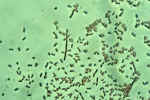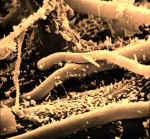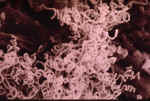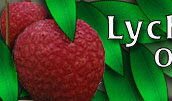The Soil Biology Primer
Chapter 3: BACTERIA
By Elaine R. Ingham
THE LIVING SOIL: BACTERIA
Bacteria are tiny, one-celled organisms – generally 4/100,000 of an
inch wide (1 µm) and somewhat longer in length. What bacteria lack in
size, they make up in numbers. A teaspoon of productive soil generally
contains between 100 million and 1 billion bacteria. That is as much mass
as two cows per acre.
|

|

|
Figure 1: A ton of microscopic
bacteria may be active in each acre of
soil.
Credit: Michael T. Holmes, Oregon
State University, Corvallis. |
Figure 2: Bacteria dot the surface of
strands of fungal hyphae.
Credit: R.
Campbell. In R. Campbell. 1985. Plant Microbiology. Edward
Arnold; London. P. 149. Reprinted with the permission of Cambridge
University Press. |
Bacteria fall into four functional groups. Most are decomposers that
consume simple carbon compounds, such as root exudates and fresh plant
litter. By this process, bacteria convert energy in soil organic matter
into forms useful to the rest of the organisms in the soil food web. A
number of decomposers can break down pesticides and pollutants in soil.
Decomposers are especially important in immobilizing, or retaining,
nutrients in their cells, thus preventing the loss of nutrients, such as
nitrogen, from the rooting zone.
A second group of bacteria are the mutualists that form
partnerships with plants. The most well-known of these are the
nitrogen-fixing bacteria. The third group of bacteria is the
pathogens. Bacterial pathogens include Xymomonas and
Erwinia species, and species of Agrobacterium that cause
gall formation in plants. A fourth group, called lithotrophs or
chemoautotrophs, obtains its energy from compounds of nitrogen,
sulfur, iron or hydrogen instead of from carbon compounds. Some of these
species are important to nitrogen cycling and degradation of pollutants.
WHAT DO BACTERIA DO?
Bacteria from all four groups perform important services related to
water dynamics, nutrient cycling, and disease suppression. Some bacteria
affect water movement by producing substances that help bind soil
particles into small aggregates (those with diameters of 1/10,000-1/100 of
an inch or 2-200µm). Stable aggregates improve water infiltration and the
soil’s water-holding ability. In a diverse bacterial community, many
organisms will compete with disease-causing organisms in roots and on
aboveground surfaces of plants.
A FEW IMPORTANT BACTERIA
Nitrogen-fixing bacteria form symbiotic associations
with the roots of legumes like clover and lupine, and trees such as alder
and locust. Visible nodules are created where bacteria infect a growing
root hair (Figure 4). The plant supplies simple carbon compounds to the
bacteria, and the bacteria convert nitrogen (N2) from air into a form the
plant host can use. When leaves or roots from the host plant decompose,
soil nitrogen increases in the surrounding area.
Nitrifying bacteria change ammonium (NH4+) to nitrite
(NO2-) then to nitrate (NO3-) – a preferred form of nitrogen for grasses
and most row crops. Nitrate is leached more easily from the soil, so some
farmers use nitrification inhibitors to reduce the activity of one type of
nitrifying bacteria. Nitrifying bacteria are suppressed in forest soils,
so that most of the nitrogen remains as ammonium.
Denitrifying bacteria convert nitrate to nitrogen (N2)
or nitrous oxide (N2O) gas. Denitrifiers are anaerobic, meaning they are
active where oxygen is absent, such as in saturated soils or inside soil
aggregates.
Actinomycetes are a large group of bacteria that grow
as hyphae like fungi (Figure 3). They are responsible for the
characteristically “earthy” smell of freshly turned, healthy soil.
Actinomycetes decompose a wide array of substrates, but are especially
important in degrading recalcitrant (hard-to-decompose) compounds, such as
chitin and cellulose, and are active at high pH levels. Fungi are more
important in degrading these compounds at low pH. A number of antibiotics
are produced by actinomycetes such as Streptomyces.
|

|

|
Figure 3: Actinomycetes, such as this
Streptomyces, give soil its "earthy" smell.
Credit:
No. 14 from Soil Microbiology and Biochemistry Slide
Set. 1976. J.P. Martin, et al., eds. SSSA, Madison, WI |
Figure 4: Nodules formed where Rhizobium
bacteria infected soybean roots.
Credit:
Stephen Temple, New Mexico State University |
WHERE ARE BACTERIA?
Various species of bacteria thrive on different food sources and in
different microenvironments. In general, bacteria are more competitive
when labile (easy-to-metabolize) substrates are present. This includes
fresh, young plant residue and the compounds found near living roots.
Bacteria are especially concentrated in the rhizosphere, the narrow region
next to and in the root. There is evidence that plants produce certain
types of root exudates to encourage the growth of protective bacteria.
Bacteria alter the soil environment to the extent that the soil
environment will favor certain plant communities over others. Before
plants can become established on fresh sediments, the bacterial community
must establish first, starting with photosynthetic bacteria. These fix
atmospheric nitrogen and carbon, produce organic matter, and immobilize
enough nitrogen and other nutrients to initiate nitrogen cycling processes
in the young soil. Then, early successional plant species can grow. As the
plant community is established, different types of organic matter enter
the soil and change the type of food available to bacteria. In turn, the
altered bacterial community changes soil structure and the environment for
plants. Some researchers think it may be possible to control the plant
species in a place by managing the soil bacteria community.
BUG BIOGRAPHY: Bacteria That Promote Plant Growth
By Ann Kennedy, USDA Agricultural Research Service, Pullman, WA
Certain strains of the soil bacteria Pseudomonas fluorescens have
anti-fungal activity that inhibits some plant pathogens. P. fluorescens
and other Pseudomonas and Xanthomonas species can increase plant growth in
several ways. They may produce a compound that inhibits the growth of
pathogens or reduces invasion of the plant by a pathogen. They may also
produce compounds (growth factors) that directly increase plant growth.
These plant growth-enhancing bacteria occur naturally in soils, but not
always in high enough numbers to have a dramatic effect. In the future,
farmers may be able to inoculate seeds with anti-fungal bacteria, such as
P. fluorescens, to ensure that the bacteria reduce pathogens around the
seed and root of the crop.
Next
chapter: Soil Fungi ->
<Return
to the Soil Biology Primer home page
Back To Lychee Info
|

